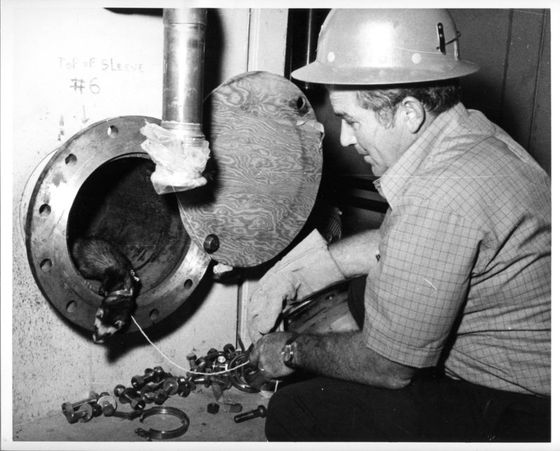Why was the ferret in the accelerator at the cutting edge science site?

The
Why Physicists Tried to Put a Ferret in a Particle Accelerator-Atlas Obscura
https://www.atlasobscura.com/articles/felicia-ferret-particle-accelerator-fermilab
Named 'Fermi National Accelerator Laboratory' after Enrico Fermi , the 'Father of the Reactor', FNAL has an accelerator consisting of a linear accelerator (Linac), a booster, recycling, and a main injector ring.
The linac is for providing protons and energy, and a booster accelerates them. Recycling groups protons together to obtain a stronger beam, and the main injector ring accelerates the beam to the speed of light by confining the beam generated by the recycling and rotating it tens of thousands of times.
A photo showing the construction of FNAL

by
Back in 1971, FNAL's accelerator design was a bit different. The point different from the current accelerator is that there was no main injector ring and no recycling. At that time, the accelerator called 'main ring' as long as 4 miles (about 6.4 km) was replacing these. The main ring is equipped with 774 'dipole magnets' for guiding particle beams passing through the inside, and 240 'quadrupole magnets' for focusing the particle beams are also mounted. It was the thing .
Each of these magnets is about 20 feet long and weighs about 13 tons. These magnets are extremely fragile, and in just two days from the accelerator operation, the insulation of the glass fiber around the coil is broken and two magnets fail. Then in a few months, the accelerator is about to replace 350 magnets.
Still on June 30, 1971, we succeeded in sending the particle beam around the main ring. However, when the energy of particles accelerated by the accelerator exceeds 7 billion electron volts (eV), the magnet will short again. Investigating the cause of failure of the accelerator, it was found that the cause was 'the metal scrap remained in the vacuum duct used for the accelerator'.
It was Ferret's felicia that was used to eliminate the cause of this failure. The photo below shows a 300-foot (about 91 meters) vacuum duct used in the accelerator at the time, and Ferretti's Ferici who ran around for dust cleaning.

British engineer Robert Sheldon first came up with the idea that ferrets might be able to clean the vacuum duct. Frank Beck, the former head of FNAL,
FNAL will source a small 15-inch long ferret from a farm located in Gaylord, Minnesota. This ferret was the smallest individual in the farm, and the fur was brown and black except for white spots on the face. FNAL purchased ferrets for $ 35 (¥ 3900) and was named Felicia.
If Felicia does a blow in the vacuum duct, it also gets in the way of stopping protons. Therefore, a thread was put around the neck of Felicia, a cotton swab soaked with detergent was put on it, and a device was designed to clean up dust and dirt in the vacuum duct. But initially, Felicia seems to have refused to enter the vacuum duct of the main ring.
Vacuum ducts for accelerators built at FNAL around 1970

by
The practice of running inside the vacuum duct in a 12-inch (about 30 cm) wide tube is carried out because it would be hard to run inside a long, deep dark vacuum duct. By this, Felicia seems to be able to run in a long vacuum duct gradually. 'The Felicia looks a bit tired and annoyed when it first runs in the vacuum duct, but it looks pretty healthy otherwise,' says Beck. Also, when I tried running Felicia, a cotton swab passed through the inside of the vacuum duct and collected dust and metal chips cleanly.
Regarding the fact that Felicia ran in the vacuum duct of the main ring, Valerie Higgins, FNAL's archivist, said that Felicia was not in danger by running in the vacuum duct. According to the staff at that time, Felicia's favorite food is chicken and liver, fish heads and raw hamburgers. When there was no space on the farm, some employees took Felicia home and spent the night together.

On the other hand, engineer Hans Kautzky created a flexible 700-meter cable for cleaning by sticking a dozen insulator disks onto a stainless steel rod to clean the vacuum duct on the main ring. By attaching this together with a permanent magnet, it seems that it is now possible to clean the inside of the vacuum duct without ferrets.
In addition, the development team has succeeded in raising the energy level without shorting the system, and with the initial goal achieved, Felicia's role in FNAL will be nearly over. After finishing his work at FNAL, Felicia died on May 9, 1972. Necropsy shows that the cause of death is the rupture of the abscess in the intestine.
It seems that there is almost no record of such a felicia, and archivist Higgins says, 'I have never found evidence that cleaning with a ferret has taken place, and now I remember it There is no one. ' Higgins seems to have tried to ask people who have worked with Felicia about that time, but because a long time has passed, many people have died and it is hard to get much information. It was said that it could not be done.
Related Posts:







